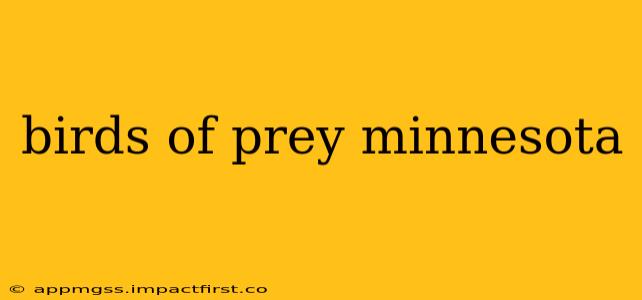Minnesota, with its diverse habitats ranging from prairies and forests to wetlands and lakes, provides a rich environment for a variety of birds of prey. These magnificent raptors play a crucial role in the state's ecosystem, controlling rodent populations and maintaining ecological balance. This guide explores the fascinating world of Minnesota's birds of prey, covering identification, habitat, and conservation efforts.
What Birds of Prey Can Be Found in Minnesota?
Minnesota is home to a significant number of diurnal (day-active) raptors. Some of the most common include:
-
Red-tailed Hawk: Perhaps the most ubiquitous bird of prey in Minnesota, the Red-tailed Hawk is easily recognizable by its namesake reddish-brown tail and broad wings. They are highly adaptable and can be found in various habitats.
-
Northern Harrier: This slender hawk with long wings and a distinctive white rump patch prefers open grasslands and marshes. They are exceptional hunters, often hovering low to the ground to spot prey.
-
American Kestrel: The smallest falcon in North America, the American Kestrel is a colorful bird with a rusty-red back and a distinctive black "mustache." They are frequently seen perched on utility poles or fence posts.
-
Bald Eagle: A majestic symbol of the United States, the Bald Eagle has made a remarkable comeback in Minnesota. They are easily identified by their white head and tail.
-
Osprey: This large, fish-eating hawk is often seen perched on tall trees or utility poles near lakes and rivers. They have distinctive hooked beaks and long, powerful talons for catching fish.
-
Rough-legged Hawk: A winter visitor to Minnesota, the Rough-legged Hawk is identifiable by its feathered legs and often a lighter-colored morph. They prefer open fields and grasslands.
What are the Most Common Birds of Prey in Minnesota?
While many raptors call Minnesota home, the Red-tailed Hawk and the Northern Harrier are arguably the most commonly sighted. Their adaptability to various habitats and widespread distribution across the state contribute to their frequent appearances. The American Kestrel, due to its smaller size and preference for open areas, is also relatively common.
Where Can I See Birds of Prey in Minnesota?
Spotting birds of prey often involves a bit of patience and knowledge of their preferred habitats. Excellent locations include:
-
State Parks and Wildlife Management Areas: These protected areas offer diverse habitats and often boast thriving raptor populations.
-
Open grasslands and prairies: Look for Northern Harriers and Rough-legged Hawks here.
-
Lakes and rivers: Osprey and Bald Eagles frequent these areas.
-
Wooded areas: Red-tailed Hawks and American Kestrels can be found in various wooded habitats.
Remember to use binoculars for better viewing and respectful observation to avoid disturbing these magnificent birds.
What is the Best Time to See Birds of Prey in Minnesota?
Migration periods (spring and fall) often offer the best opportunities to spot a wide variety of raptors as they travel through the state. However, many birds of prey are resident throughout the year, making sightings possible year-round. Winter offers a chance to see species like the Rough-legged Hawk that are not present during the summer months.
What Eats Birds of Prey in Minnesota?
While adult birds of prey are apex predators in their respective ecological niches, their young or weaker individuals may fall prey to larger predators. Great Horned Owls, for instance, are known to prey on smaller raptors, especially their young. Other potential predators include larger mammals like coyotes or foxes, which might target nests or young birds.
How Can I Help Protect Birds of Prey in Minnesota?
Protecting birds of prey requires a multifaceted approach:
-
Support conservation organizations: Organizations like the Raptor Center work tirelessly to rehabilitate injured birds and promote conservation efforts.
-
Reduce pesticide use: Pesticides can negatively impact the food chain, affecting birds of prey indirectly.
-
Protect their habitats: Support initiatives that preserve grasslands, forests, and wetlands.
-
Report injured birds: If you encounter an injured bird of prey, contact a wildlife rehabilitation center.
By understanding and appreciating these magnificent creatures and supporting conservation efforts, we can help ensure that Minnesota's birds of prey continue to thrive for generations to come.
